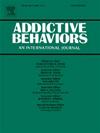Leveraging social media and large language models for scalable alcohol risk assessment: Examining validity with AUDIT-C and post recency effects
IF 3.6
2区 医学
Q1 PSYCHOLOGY, CLINICAL
引用次数: 0
Abstract
Risky alcohol consumption is a major public health concern, yet significant barriers exist to effective screening. The present study examines the potential of Large Language Models (LLMs) to infer risky alcohol use from social media text. The unobtrusive nature of this approach could provide a more scalable way to assess alcohol risk in large populations. To this aim, we analyzed Facebook status updates from 208 adults from Italy (mean age = 26.8, 70.7 % female) who also completed the Alcohol Use Disorders Identification Test-Consumption (AUDIT-C), a brief validated self-report measure of risky drinking. Two state-of-the-art LLMs, Gemini 1.5 Pro and GPT-4o, were used to assess alcohol risk and to quantify alcohol references. Results demonstrated strong inter-model agreement between risk inferences (ρ = 0.572, p < 0.001). LLM-inferred risk scores showed moderate correlations with AUDIT-C scores (Gemini 1.5 Pro: ρ = 0.344, p < 0.001; GPT-4o: ρ = 0.375, p < 0.001; Average: ρ = 0.405, p < 0.001). These correlations were significantly stronger among participants with recent posts (Average risk score: ρ = 0.500, p < 0.001) than among those without (ρ = 0.294, p = 0.008). The strongest correlation was observed between average LLM-inferred risk scores and AUDIT-C in the recent posts group (disattenuated ρ = 0.606). These findings suggest that LLMs offer a promising tool for identifying risky alcohol use when analyzing recent social media activity. Their accuracy is comparable to some traditional alcohol assessment methods, highlighting their potential to enhance early detection efforts. Limitations and future research directions are discussed.
利用社交媒体和大型语言模型进行可扩展的酒精风险评估:使用AUDIT-C和post - recent effects检查有效性
危险饮酒是一个主要的公共卫生问题,但在有效筛查方面存在重大障碍。本研究考察了大型语言模型(llm)从社交媒体文本中推断酒精使用风险的潜力。这种方法不引人注目的性质可以提供一种更可扩展的方法来评估大量人群的酒精风险。为此,我们分析了来自意大利的208名成年人(平均年龄为26.8岁,70.7%为女性)的Facebook状态更新,这些成年人还完成了酒精使用障碍识别测试-消费(AUDIT-C),这是一种简短的有效的危险饮酒自我报告测量。两个最先进的法学硕士,Gemini 1.5 Pro和gpt - 40,用于评估酒精风险和量化酒精参考。结果显示,模型间风险推断具有很强的一致性(ρ = 0.572, p <;0.001)。llm推断的风险评分与AUDIT-C评分呈中等相关性(Gemini 1.5 Pro: ρ = 0.344, p <;0.001;gpt - 40: ρ = 0.375, p <;0.001;平均值:ρ = 0.405, p <;0.001)。这些相关性在最近发帖的参与者中显著增强(平均风险评分:ρ = 0.500, p <;0.001),与对照组相比(ρ = 0.294, p = 0.008)。在最近的帖子组中,llm推断的平均风险评分与AUDIT-C之间的相关性最强(去衰减ρ = 0.606)。这些发现表明,法学硕士在分析最近的社交媒体活动时,为识别危险的酒精使用提供了一个很有前途的工具。它们的准确性与一些传统的酒精评估方法相当,突出了它们在加强早期检测工作方面的潜力。讨论了局限性和未来的研究方向。
本文章由计算机程序翻译,如有差异,请以英文原文为准。
求助全文
约1分钟内获得全文
求助全文
来源期刊

Addictive behaviors
医学-药物滥用
CiteScore
8.40
自引率
4.50%
发文量
283
审稿时长
46 days
期刊介绍:
Addictive Behaviors is an international peer-reviewed journal publishing high quality human research on addictive behaviors and disorders since 1975. The journal accepts submissions of full-length papers and short communications on substance-related addictions such as the abuse of alcohol, drugs and nicotine, and behavioral addictions involving gambling and technology. We primarily publish behavioral and psychosocial research but our articles span the fields of psychology, sociology, psychiatry, epidemiology, social policy, medicine, pharmacology and neuroscience. While theoretical orientations are diverse, the emphasis of the journal is primarily empirical. That is, sound experimental design combined with valid, reliable assessment and evaluation procedures are a requisite for acceptance. However, innovative and empirically oriented case studies that might encourage new lines of inquiry are accepted as well. Studies that clearly contribute to current knowledge of etiology, prevention, social policy or treatment are given priority. Scholarly commentaries on topical issues, systematic reviews, and mini reviews are encouraged. We especially welcome multimedia papers that incorporate video or audio components to better display methodology or findings.
Studies can also be submitted to Addictive Behaviors? companion title, the open access journal Addictive Behaviors Reports, which has a particular interest in ''non-traditional'', innovative and empirically-oriented research such as negative/null data papers, replication studies, case reports on novel treatments, and cross-cultural research.
 求助内容:
求助内容: 应助结果提醒方式:
应助结果提醒方式:


